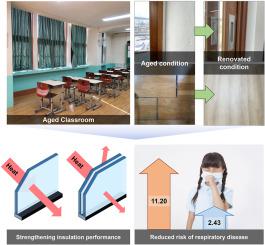当前位置:
X-MOL 学术
›
Environ. Pollut.
›
论文详情
Our official English website, www.x-mol.net, welcomes your feedback! (Note: you will need to create a separate account there.)
Synergistic approaches to elevate indoor air quality: A holistic examination of classroom refinement, air exchange optimization, and flooring material impact
Environmental Pollution ( IF 8.9 ) Pub Date : 2024-04-04 , DOI: 10.1016/j.envpol.2024.123920 Ho Hyeon Jo , Yujin Kang , Sumin Kim
Environmental Pollution ( IF 8.9 ) Pub Date : 2024-04-04 , DOI: 10.1016/j.envpol.2024.123920 Ho Hyeon Jo , Yujin Kang , Sumin Kim

|
This research endeavors to elevate indoor air quality within aging school environments by concentrating on refining interior finishing materials and windows. Renovations, encompassing window and floor remodeling in classrooms, aim to mitigate particulate matter (PM) infiltration and enhance air exchange rates. Utilizing SPS30 sensors for the analysis of 0.3–2.5 μm particles, with a focus on their implications for human health, the study evaluated air exchange rates, deposition rates, infiltration rates, and particle generation during classroom activities. Post-renovation results demonstrated a noteworthy decrease in air exchange rates, indicating an enhancement in airtightness. The investigation delves into particle generation with various flooring materials, accentuating the importance of opting for durable and low-particle-generating alternatives. Health risk assessments, considering multiple exposure routes (inhalation, dermal contact, and ingestion), revealed reduced risks post-renovation, particularly for children. To further optimize indoor air quality, the study suggests the implementation of air purification systems. Examination of PM generation during student activities showcased a substantial reduction post-renovation. This study underscores the positive influence of architectural enhancements on indoor air quality while acknowledging the necessity for holistic solutions and continuous research.
中文翻译:

提高室内空气质量的协同方法:对教室改进、空气交换优化和地板材料影响的整体检查
这项研究致力于通过改进室内装饰材料和窗户来提高老化学校环境中的室内空气质量。翻新工程包括对教室的窗户和地板进行改造,旨在减少颗粒物 (PM) 渗透并提高空气交换率。该研究利用 SPS30 传感器分析 0.3–2.5 μm 颗粒,重点关注其对人类健康的影响,评估了课堂活动期间的空气交换率、沉积率、渗透率和颗粒产生。翻新后的结果表明,空气交换率显着下降,表明气密性有所增强。该调查深入研究了各种地板材料产生的颗粒,强调了选择耐用且低颗粒产生替代品的重要性。考虑到多种暴露途径(吸入、皮肤接触和摄入)的健康风险评估显示,装修后的风险降低了,特别是对于儿童而言。为了进一步优化室内空气质量,研究建议实施空气净化系统。对学生活动期间 PM 生成的检查表明,改造后 PM 生成量大幅减少。这项研究强调了建筑增强对室内空气质量的积极影响,同时承认整体解决方案和持续研究的必要性。
更新日期:2024-04-04
中文翻译:

提高室内空气质量的协同方法:对教室改进、空气交换优化和地板材料影响的整体检查
这项研究致力于通过改进室内装饰材料和窗户来提高老化学校环境中的室内空气质量。翻新工程包括对教室的窗户和地板进行改造,旨在减少颗粒物 (PM) 渗透并提高空气交换率。该研究利用 SPS30 传感器分析 0.3–2.5 μm 颗粒,重点关注其对人类健康的影响,评估了课堂活动期间的空气交换率、沉积率、渗透率和颗粒产生。翻新后的结果表明,空气交换率显着下降,表明气密性有所增强。该调查深入研究了各种地板材料产生的颗粒,强调了选择耐用且低颗粒产生替代品的重要性。考虑到多种暴露途径(吸入、皮肤接触和摄入)的健康风险评估显示,装修后的风险降低了,特别是对于儿童而言。为了进一步优化室内空气质量,研究建议实施空气净化系统。对学生活动期间 PM 生成的检查表明,改造后 PM 生成量大幅减少。这项研究强调了建筑增强对室内空气质量的积极影响,同时承认整体解决方案和持续研究的必要性。



























 京公网安备 11010802027423号
京公网安备 11010802027423号